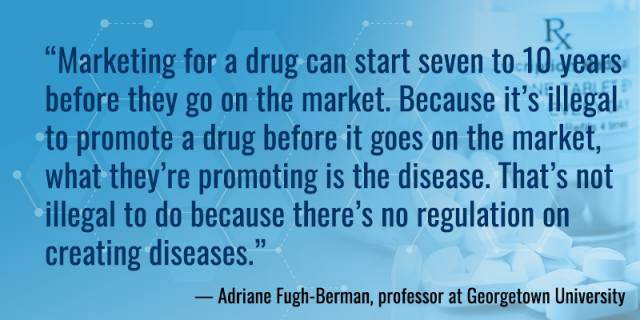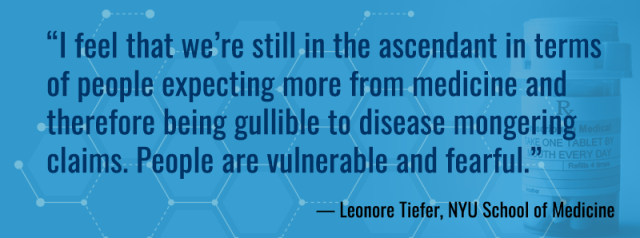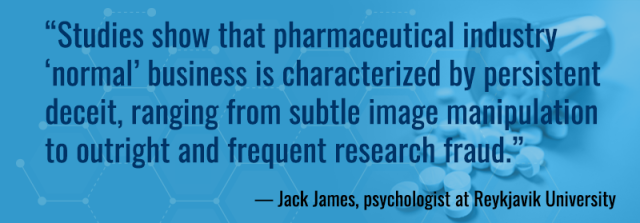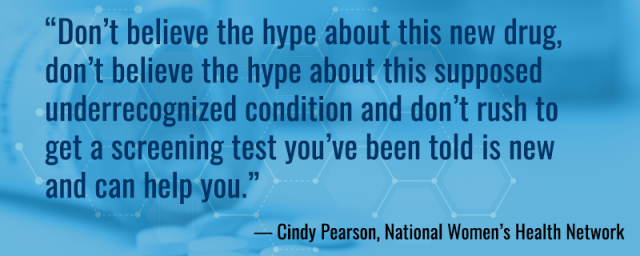
The pharmaceutical industry’s image has been significantly damaged in recent years as the public discovered the role its aggressive marketing played in fueling the opioid epidemic. But the American people are still largely in the dark about what may be pharma’s most effective tactic for pushing drugs — marketing diseases.
There’s a substantial body of medical literature dating back to the early ’90s about the practice known as “disease mongering.” Pharmaceutical companies regularly pathologize everyday experiences, convince doctors that they are serious problems, tell a hypochondriacal public it needs help and offers the cure: a new drug. Against the onslaught of billions of dollars in marketing campaigns each year, however, researchers’ warnings about these tactics have gone largely unheeded.
To be clear: Pharmacology has helped countless people recover from illness or lead more productive lives. But the number of patients receiving any given drug is often greater than those who would benefit from it, and often includes people it could harm.
The United States was still the largest single pharmaceutical market in 2017, generating more than $450 billion of revenue. In contrast, all of Europe accounted for roughly $214 billion. U.S. pharmaceutical spending alone is double the Organisation for Economic Co-operation and Development average. According to the Mayo Clinic, nearly 70 percent of Americans take at least one prescription drug.
Adriane Fugh-Berman, a professor of pharmacology at Georgetown University Medical Center, said the pharmaceutical industry medicalizes normal life by positing that a vague, highly relatable, everyday condition is symptomatic of a newly invented disease. In other cases, pharma exaggerates the prevalence or severity of an existing condition to entice more customers.
“Marketing for a drug can start seven to 10 years before they go on the market. Because it’s illegal to promote a drug before it goes on the market, what they’re promoting is the disease. That’s not illegal to do because there’s no regulation on creating diseases,” Fugh-Berman told Yahoo News.
Lisa Schwartz and Steven Woloshin, co-directors of the Center for Medicine and Media at Dartmouth Institute for Health Policy and Clinical Practice, said disease-awareness campaigns may seem caring or educational but are often just marketing in disguise. The campaigns often follow three basic steps: lower the bar for diagnosis, raise the stakes so people want to get tested and spin the evidence about a drug’s benefits and risks. These steps were seen in campaigns on testosterone deficiency, bipolar disorder and restless leg syndrome.

“Low testosterone was among the biggest cases of disease mongering — a huge increase in prescribing a drug before the benefits and harms of treatment were established,” Schwartz said. “And yet, manufacturers claimed ‘low T’ — not aging or other medical conditions — was the reason why older men might have less energy, worse sports performance or even feeling more tired after dinner than younger men. There are no specific rules about how companies can talk about symptoms in awareness campaigns.”
Jack James, a clinical psychologist at Reykjavik University in Iceland, said the image of the pharmaceutical industry as a dynamic global enterprise burgeoning with breakthrough innovations serving the common good is a public relations concoction that obscures the fact that most new drugs are minor variations on existing formulations.
“Most are, at best, expensive marginal improvements on the older and cheaper drugs they are intended to replace, and a substantial proportion of new drugs are more harmful than older formulations. In practice, the emphasis in drug development is on marketing fake innovation rather than genuine innovation,” James said.
James’s book “The Health of Populations” focuses on the importance of behavioral changes to prevent diseases. He said the cultivation of direct personal relationships between industry representatives and physicians is nearly universal at all levels of private and public healthcare. For example, he said, the pharmaceutical industry gives gifts both large (e.g., sponsored trips) and small (e.g., pens and note pads) to encourage particular prescribing patterns — a boon to the industry at the potential cost of harm to the patients, or at best a waste of money by consumers, insurers and the government.
Leonore Tiefer, a sexologist and psychologist at New York University School of Medicine, said the public is susceptible to exploitation by drug companies and thinks the trend will likely continue in the wrong direction.
“I feel that we’re still in the ascendant in terms of people expecting more from medicine and therefore being gullible to disease-mongering claims. People are vulnerable and fearful,” Tiefer said.
According to a study in the British Medical Journal, pharmaceutical companies spend $19 on advertising a new drug for every one dollar spent on the research and development process.
When asked about disease mongering, Mitchell J. Katz, a public affairs specialist at the Federal Trade Commission, said his agency does not have jurisdiction over pharmaceutical advertising and that it’s handled by the FDA.
“We also don’t ‘regulate’ advertising, but we do bring action in cases where ads are deceptive, misleading, or the claims they make are not supported by competent and reliable scientific information. But only ads for products within our enforcement jurisdiction,” Katz wrote in an email.

Under the Federal Food, Drug, and Cosmetic Act, the FDA requires that all drug advertisements and promotional labeling include a brief summary of side effects, effectiveness and indications of when the drug should not be taken. The FDA prohibits ads from omitting relevant facts, including misleading information or failing to present a fair balance between effectiveness and risks. But promotional material that does not actually mention prescription drugs would not fall under the FDA’s jurisdiction, which is established by Congress.
The FDA has an expedited approval process for drugs that address rare diseases, defined as those that affect fewer than 200,000 people. In some cases, drug companies subdivide common diseases so they can be classified as rare diseases to get expedited approval. More often, though, they do the opposite: broaden the definition of an actual disease that only affects a handful of people to increase the market for a drug to treat it.
In the end, Fugh-Berman said, there’s no authority that protects against questionable disease categories in any meaningful way.
Schwartz and Woloshin work to improve communication between doctors and the public by helping both see through the disproportionate fears and hopes created by medical advertising and selective reporting. They note that health conditions occupy a spectrum from clearly sick to clearly well, but there’s a large gray area in-between. When does a mildly bothersome experience become the symptom of a disease? In many cases, they said, the pharmaceutical industry draws these lines aggressively so the boundaries of normal get smaller and smaller. And they do so unilaterally — no regulators are watching.
“Everyone’s legs feel restless now and then, or they feel occasional stinging or burning sensations in their eyes. But far less people have symptoms severe enough to need medical treatment. The problem is that manufacturers increasingly target people with mild symptoms in order to turn them into patients. Unfortunately, treatment may offer little benefit and may not outweigh side effects, cost and inconvenience,” Woloshin said.
Woloshin said pharmaceutical company print or online advertisements sometimes feature quizzes that include symptoms associated with a condition, but which the drug did not help in clinical trials.
“Consumers naturally think, ‘I see the list of things on this quiz. The drug must treat these things,’ even though it doesn’t. It’s a trick,” Woloshin said.
My interviews for this article suggest that the public should be skeptical about quizzes for diseases, as they are often unreliable and ask leading questions meant to convince healthy people they suffer from a newly discovered ailment.
Schwartz and Woloshin wrote an article for the JAMA Internal Medicine journal on how the low T campaign was essentially a template for how diseases are sold. Are you a middle-aged man who sometimes feels tired? Has your athletic ability declined at all since your early 20s? Well, that used to be called aging. But these unvalidated online quizzes might suggest you suffer from low T. Lucky for you, Abbott Laboratories manufactures Androgel.
“I think social media can be a disaster for blurring the line between marketing and public health. The marketing world is trying to get more and more companies to do disease-awareness on Facebook since they can tell stories and directly interact with people,” Schwartz said. “These sites give you the feeling that someone out there is just trying to help you and give credence to your suffering — not that a company is trying to sell a drug.”
Fugh-Berman recalled taking an online test with her coworkers at PharmedOut, a group she directs at Georgetown that exposes pharmaceutical marketing and promotes evidence-based prescribing. The test on pseudobulbar affect (PBA), which manifests when specific brain damage leads to laughing or crying that is inappropriate and unconnected to a person’s emotions, suggested that normal human expressions could be signs of PBA with questions like “Do you ever find things funny that other people don’t find funny?” and “Do you cry easily?”
“Almost every woman failed. Only one woman passed. Most of the men failed, but more of them passed. I would say that anyone who passed the test I was actually worried about,” Fugh-Berman said.
PharmedOut’s research focuses on the effectiveness of continuing medical education (CME) funded by the pharmaceutical industry, as well as contrived or exaggerated diseases. She said pharmaceutical companies get doctors on their advisory boards and pay them to educate other influential doctors at CME events. These thought leaders also sign their names to articles — whether written by them or not — so that the company’s views find their way into medical literature. When drugs are approved and diseases are accepted as treatable, medical students are then taught to treat what were once considered benign conditions.
“The trouble is that people are very reluctant to believe that things that sound so scientific and medical and are promoted so aggressively by scientific and medical experts could be mythical or at the very best exaggerated,” Tiefer said. “People don’t want to believe that.”

James said private and public interests are so entangled in the health care industry’s research infrastructure that it undermines the integrity of scientific research ostensibly conducted for public benefit.
“Studies show that pharmaceutical industry ‘normal’ business is characterized by persistent deceit, ranging from subtle image manipulation to outright and frequent research fraud,” James said. “Individual researchers, who may have the best of intentions but whose work is conducted in collaboration with industry, are subject to a variety of biasing influences.”
Self-serving bias, an unconscious process in which judgments, decisions and conclusions favor personal interests over the general good, is chief among these cognitive blind spots. James said these sorts of cognitive biases affecting researchers are nearly impossible to regulate through ethical-conduct codes or public disclosure of conflicts.
“Despite irrefutable evidence of extensive patient harm, years of attempts to prevent harm due to conflicts of interest have failed dismally,” James said.
Cindy Pearson is the executive director of National Women’s Health Network (NWHN), which came into being 40 years ago. Many women had been given drugs they didn’t need or were never told the truth about the drugs they were taking. Although drug mongering affects men too, she said, women are more likely to be targeted partly because they are often the health-care decision makers for their families, keeping abreast of what’s new and making sure their families meet recommendations for hygiene, vaccinations and medical tests.
She said the NWHN looks at claims of new conditions very skeptically and is willing to tell women, “Don’t believe the hype about this new drug, don’t believe the hype about this supposed under-recognized condition and don’t rush to get a screening test you’ve been told is new and can help you.”
“I feel that there are people involved in creating new diseases and promoting drugs that aren’t really needed who are pretty amoral. Their measurement of success for themselves is strictly sales,” Pearson said. “There are good-spirited and good-hearted people in companies who are proud of developing something that provides help to some people — and then their marketing department gets ahold of it and turns it into something else.”
Fugh-Berman said gastroesophageal reflux disease (GERD) is essentially what used to be called reflux or heartburn. Doctors used to tell patients to eat less, drink less alcohol, not go to sleep on a full stomach and take Tums as needed. But the problem with heartburn is that customers would only need a drug when they are experiencing it.

“What’s really brilliant about having people take it chronically is when they stop they get a high acid rebound syndrome that will cause them to be in pain. They think, ‘Oh I really need this drug,’ and go back on it,” Fugh-Berman said.
Fugh-Berman pointed out that there have been invented diseases in the past, such as female hysteria and chlorosis in the 19th century, but that “they weren’t invented by drug companies.”
Medical journalist Lynn Payer coined the phrase “disease mongering” in her 1992 book “Disease Mongers: How Doctors, Drug Companies, and Insurers are Making You Feel Sick.” She defined the practice as “trying to convince essentially well people that they are sick, or slightly sick people that they are very ill.” Evidence supporting her thesis has only grown since the book was published.
Journalist Ray Moynihan and pharmacologist David Henry continued this research into the new millennium, arguing in a 2002 British Medical Journal (BMJ) article that informal alliances of pharma staff, doctors and consumer groups have engaged in “public awareness” campaigns about underdiagnosed conditions — promoting a disease as pervasive and serious, yet curable. Pharma marketing strategies, they said, downplay the importance of personal coping strategies — or the fact that a condition is essentially benign.
“Pharmaceutical companies are actively involved in sponsoring the definition of diseases and promoting them to both prescribers and consumers. The social construction of illness is being replaced by the corporate construction of disease,” Moynihan and Henry wrote.
PLOS (Public Library of Science) Medicine published a special issue in April 2006 focused on disease mongering following an inaugural conference on the topic. Tiefer described the conference as the beginning of a “less-is-more” movement to roll back over-diagnosing and excessive treatments. This movement is largely but not exclusively aimed at challenging the claims of pharmaceutical advertisers. These activists, researchers and doctors are also concerned about traditional, ritualistic practices of medicine, like vast amounts of screening and routine testing that leads to more diagnosis and treatment than is beneficial.
Pearson advocates for regulations on drug marketing, both in medical education and consumer-directed campaigns, to scale back a competitive environment in which every new drug needs to be a blockbuster and make a billion dollars in annual sales.
“You can’t do that unless you’re willing to price a new drug for a relatively small group of people through the stratosphere, which we do see in cancer and other terribly serious conditions. But if you’re marketing a drug that no one will pay that much for because the condition isn’t that terrible, then you have to market it to a heck of a lot of people.”

For example, she said osteoporosis, an actual condition in which fragile bones are more susceptible to fracture, was blown out of proportion by drug companies who overpromoted bone-strength screening tests — leading many women into drug use that only harmed them.
“Companies who brought the first non-hormonal drug to market about 30 years ago wanted a larger market than just the very old who were already suffering from osteoporosis,” she said.
So pharmaceutical companies invested in the mass production of what had been a research tool called DEXA (Dual-energy X-ray absorptiometry) and made it ubiquitous. They placed DEXA machines in primary care physicians’ offices for free, manufactured them en masse so the price would drop, funded an older women’s group to run an education campaign about the importance of screening, funded another group to run a toll-free hotline that women could call to learn of where they can get screened and funded a meeting of experts to determine which level of bone loss would be considered osteoporosis.
“What they also did at that meeting, which was supported by the drug companies, was create a condition called osteopenia, which is less than normal but not osteoporosis,” she said. “Then the company started telling doctors that they should get women on these treatment drugs to prevent the development of full-blown osteoporosis.”
In other words, they created osteopenia as a disease and outlined recommendations to treat healthy women with the same drug used by women with actual osteoporosis. This worked for about 20 years. Millions of women took the drug who didn’t need to with no proof that it would prevent hip fractures when they’re older.
“Some of those women suffered as a result with a type of fracture that had been previously rare called ‘atypical femur fractures,’” Pearson said. These are fractures in the long bone of the thigh that cause trauma. “They created a trap with a screening test that was useful to the few, but the creation of this so-called condition of osteopenia pushed millions of women to take a drug that wound up hurting them.”
Pearson called osteopenia “disease mongering plain and simple.”
Tiefer said that the creation and promotion of female sexual dysfunction (FSD) is a textbook example of disease mongering. She explained that FSD assumes there’s such a thing as “Female Sexual Function,” a normal sex life regarding sex drive, sexual response, kinds of desires or preferred sexual activities. She said these qualities have far more to do with individual and cultural preferences than any sort of medical norms or health standards.
“But people have been influenced by a parade of experts who wanted to create a field called ‘sexual medicine’ — an industry. And they of course were aided and abetted by the pharmaceutical industry. I think it’s both of those things together. It’s ambition on the part of a lot of health practitioners and the bottomless greed of the pharmaceutical industry,” she said.
The marketing strategy behind disease mongering is to link a disease with a drug. In the face of such close brand association, it can be difficult for a new drug to break into the market, so companies have an incentive to develop diagnostic distinctions. If you alter the description slightly and come up with a new disease, you can open up an entirely new market that you can dominate.

“That happened with Paxil. They had a serotonin reuptake inhibitor that was late to market, so they redefined shyness to be social anxiety disorder,” Fugh-Berman said, “Cymbalta was the drug where it was just another antidepressant, so they linked depression and pain. They didn’t really create another disease but they distinguished their antidepressant as the one you should use in your patient with depression and pain. It’s really sort of brilliant and their advertising line was “depression hurts.’”
Fugh-Berman said hypoactive sexual desire disorder was invented to prepare the market for a testosterone patch, which never got approval in the U.S. But the disease stuck around. It was revived by the company that wound up selling Addyi (flibanserin).
“So, the disease was already out there, having been invented by one drug company and expanded by another, which is really kind of depressing,” Fugh-Berman said.
The experts agreed that medical harm from disease mongering, which ranges from temporary to fatal, constitutes a health crisis in which damages are borne almost entirely by patients — despite going largely unnoticed by them.
According to James, prescription drugs are responsible for more harm than both surgery and health care-acquired infections. Though it’s difficult to measure the full extent of prescription-fueled harm, successive studies show that it has been growing.
“For example, estimates of the extent of harm in the United States published by the Institutes of Medicine in 2000, which at that time were considered so shocking as to be disbelieved by some authorities, have since been consistently eclipsed by new and more detailed analyses,” James said. “Recent studies show that harm caused by prescription drugs alone exceeds that which was previously thought to represent the total of health care-related harm from all causes.”
The Pharmaceutical Research and Manufacturers of America and the Biotechnology Innovation Organization, the top trade groups for the pharmaceutical industry in the U.S., did not respond to requests for comment.

No comments:
Post a Comment